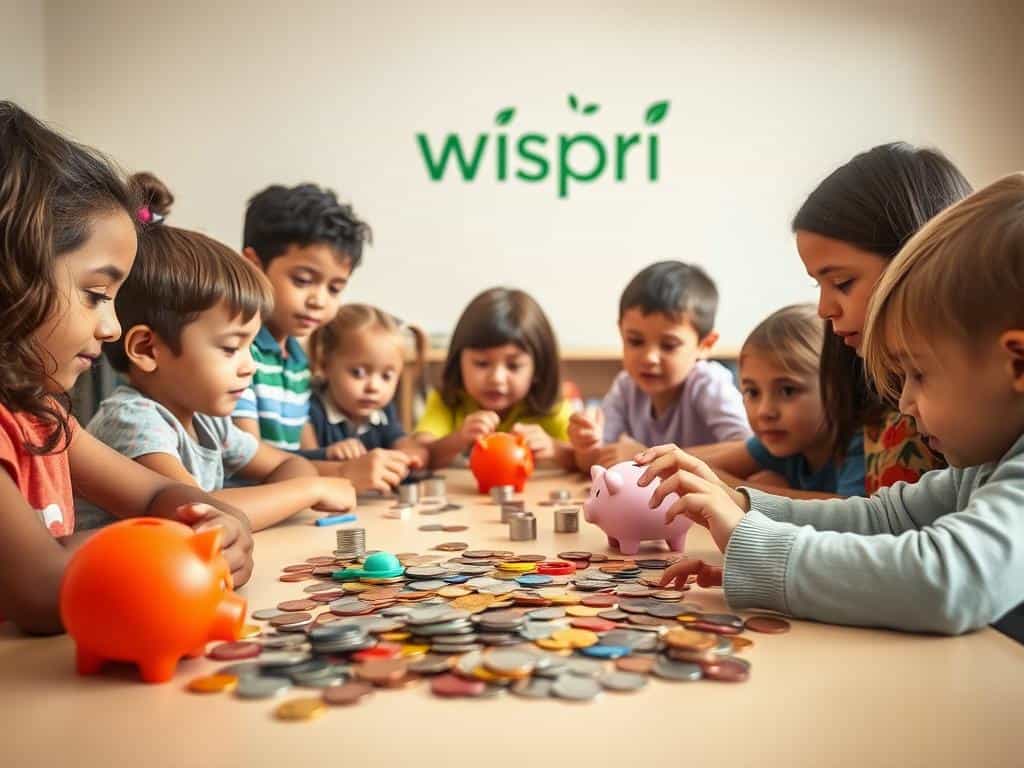In Australia, many children lack a fundamental understanding of money management, leading to poor financial decisions later in life. Financial literacy is a vital life skill that can be nurtured from a young age.
Parents play a significant role in shaping their children’s financial habits. By introducing concepts like saving, spending, and budgeting, families can help kids develop healthy relationships with money. In today’s digital economy, it’s essential for children to understand both traditional and modern aspects of financial management.
With tools like Wispri, Australia’s leading price tracking platform, families can teach price awareness in a real-world context. This comprehensive guide will explore age-appropriate strategies for imparting financial skills to children.
Key Takeaways
- Financial literacy starts at home with parental guidance.
- Children need to understand both traditional and modern financial management.
- Tools like Wispri can aid in teaching price awareness.
- Age-appropriate strategies are crucial for effective financial education.
- Developing healthy financial habits from a young age is vital.
The Importance of Financial Literacy for Children
Equipping children with financial knowledge is essential for their long-term financial stability. Learning about money and developing financial literacy from a young age can help children develop responsible money habits and attitudes for later in life. Financial literacy is closely linked to general literacy and numeracy skills, enabling children to read price tags, add up costs, and make informed money management decisions.

As children grow, their understanding of financial concepts can be refined and expanded. Research highlights that money habits and attitudes are formed early in childhood, making it crucial to introduce financial concepts before potentially harmful money behaviors develop.
Building Foundations for Future Financial Success
Teaching kids about financial literacy helps them understand the connection between work and earning, delayed gratification, and the difference between needs and wants. By introducing these concepts early, children can develop a healthy relationship with money that will serve them throughout adulthood. It’s a critical life skill that empowers children to make informed decisions about money, from everyday purchases to major investments.
When to Start Teaching Money Concepts
Australian parents can begin introducing basic money concepts as early as age 4-5, when children start developing the cognitive ability to understand simple financial ideas. The foundation of financial literacy includes understanding what money is, where it comes from, how it’s earned, and the basics of saving and spending wisely. By starting early, parents can help their children build a strong financial foundation.
Understanding Basic Money Concepts for Different Age Groups
Financial literacy for kids is not a one-size-fits-all approach; it varies by age. As children grow, they can grasp more complex money concepts, making it essential to tailor financial education to their age.
Ages 4-7: What Money Looks Like and Where It Comes From
For young children, introducing the physical aspects of money is crucial. This includes identifying coins and notes, understanding that money is exchanged for goods, and explaining where family money comes from. Using visual aids like play money can help.
Ages 8-12: Needs vs. Wants and Basic Budgeting
As children enter this age group, they can start understanding the difference between needs and wants. This distinction forms the foundation of budgeting skills. Encouraging them to save for specific goals and make basic spending decisions with guidance is beneficial.
Teens: Advanced Money Management and Digital Finance
Teenagers are ready for advanced concepts like digital banking, online shopping safety, and the basics of investing. They should learn about management of their finances, including saving and spending wisely.
| Age Group | Key Concepts |
|---|---|
| 4-7 | Identifying money, understanding its source |
| 8-12 | Needs vs. wants, basic budgeting |
| Teens | Advanced money management, digital finance |

Introducing Pocket Money as a Teaching Tool
Pocket money serves as a hands-on tool for teaching children about financial management. It’s a practical way to give kids experience in managing their own finances in a controlled environment.
How Much to Give and How Often
Determining the right amount of pocket money depends on your family’s financial situation and the child’s age. A common guideline is to give $1 per week per year of age, so a five-year-old would receive $5 weekly. Regular allowances, whether weekly or fortnightly, help children learn to budget.
Cash vs. Digital Pocket Money
The choice between cash and digital pocket money depends on the child’s age and your teaching goals. Physical cash helps younger children visualize money, while digital options through banking apps teach older children about modern financial management.
Should Pocket Money Be Tied to Chores?
Whether to tie pocket money to chores is a personal decision. Some parents believe it teaches work ethic, while others prefer children to help around the house as part of family responsibility. Consistency is key, regardless of the approach chosen.
Teaching Kids Money Through Saving Goals
Encouraging kids to set savings goals is an effective way to teach them about money management. By setting clear objectives, children can learn valuable lessons about delayed gratification and financial planning.

Setting Age-Appropriate Savings Targets
It’s essential to set age-appropriate savings targets for kids. Younger children can start with short-term goals, such as saving for a small toy, while older kids can work towards longer-term objectives.
Creating Visual Savings Trackers
Using visual savings trackers like charts or jars can help kids monitor their progress and stay motivated.
Celebrating Savings Milestones
Celebrating savings milestones reinforces positive financial behavior and motivates kids to continue developing good saving habits.
By teaching kids to save for different purposes, such as short-term wants, long-term goals, and giving to others, parents can help them understand comprehensive money management.
Smart Shopping Skills for Children
Smart shopping skills are essential for children to become discerning consumers. Teaching children to shop smartly involves more than just comparing prices; it’s about understanding the value of things and making informed purchasing decisions.

Comparing Prices and Understanding Value
Children should learn to compare prices across different stores and online platforms to understand market variations. This helps them develop a habit of researching before buying and understanding the concept of value versus price.
Recognising Marketing Tactics
It’s crucial for children to recognise common marketing tactics and advertising strategies that influence their purchasing decisions. By understanding these tactics, children can make more informed choices and avoid impulse buying.
Making Thoughtful Purchasing Decisions
Teaching children to pause before making impulse purchases by implementing a “waiting period” for non-essential items helps develop thoughtful spending habits. This encourages them to think critically about their purchasing decisions.
Using Technology to Teach Price Awareness
Modern technology offers a range of tools to help children develop essential skills in price comparison and smart shopping. By leveraging these tools, parents can provide their kids with a comprehensive understanding of price awareness and smart spending.
Introducing Wispri for Price Tracking
Wispri is Australia’s leading price tracking platform that helps smart shoppers save money by monitoring product prices across multiple retailers and sending instant alerts when prices drop to desired levels. With its user-friendly dashboard and customizable price drop alerts, Wispri is an ideal tool for teaching kids about price awareness.
![]()
Teaching Kids to Monitor Prices for Better Deals
By involving kids in the process of monitoring prices using Wispri, parents can teach them the value of patience and strategic purchasing. Kids can learn to track prices across major Australian retailers, understand sales cycles, and make informed purchasing decisions.
The use of Wispri as an educational tool not only teaches children about price awareness but also provides a practical application of mathematics, as they calculate potential savings and percentage discounts. This hands-on experience helps kids develop critical thinking skills about where and when to make purchases, ultimately becoming smarter consumers.
Practical Money Activities for Different Ages
Hands-on money activities are an effective way to teach children about money management across various age groups. Engaging in these activities helps kids develop essential financial skills in an engaging and interactive manner.
Money Games and Role Play
For younger children, setting up pretend shops or restaurants at home allows them to practice using money, making change, and understanding basic transactions through role play. Board games like Monopoly Junior also provide entertaining ways to learn about earning, spending, and financial consequences.
Budgeting Projects
Primary school kids benefit from budgeting projects like planning a family meal within a set budget. This requires them to research prices, make shopping lists, and manage limited resources.
Real-World Challenges
Teenagers can engage with real-world money challenges such as researching and comparing mobile phone plans or managing a clothing budget for a season.
- Hands-on activities make abstract money ideas concrete and engaging.
- Role-playing with money helps younger kids understand basic transactions.
- Budgeting projects teach primary school kids to manage resources.
Avoiding Common Mistakes When Teaching Kids About Money
Teaching children about financial responsibility is crucial, yet many parents inadvertently make mistakes that can hinder their kids’ understanding of money management. Children learn a lot about money management from watching how you use money in your everyday family life.
Shielding Kids from Financial Realities
Shielding children from family financial realities can prevent them from understanding household budgeting and financial constraints. It’s essential to involve kids in age-appropriate discussions about money to help them develop a healthy understanding of financial management.
Missing Teachable Moments in Everyday Life
Everyday life is filled with teachable money moments that parents often miss. Comparing prices while grocery shopping or explaining bill payments are opportunities to educate kids about money management.
Inconsistent Money Messages
Inconsistent money messages confuse children. For instance, emphasizing saving while making impulsive purchases sends mixed signals. Parents should strive to model consistent financial behavior to avoid confusing their kids.
By being aware of these common mistakes, parents can take steps to provide their children with a comprehensive financial education.
Conclusion: Raising Financially Savvy Kids in the Digital Age
Raising financially savvy kids in today’s digital age requires a balanced approach that combines traditional money management lessons with modern financial tools and technologies. As the financial landscape continues to evolve, it’s crucial for children to develop smart spending habits and a deep understanding of financial literacy.
By leveraging tools like Wispri, parents can provide their kids with hands-on experience in tracking prices and making informed purchasing decisions. This, coupled with consistent, age-appropriate money lessons, creates a progressive learning journey that builds confidence and competence in financial decision-making. The goal is to develop well-rounded financial thinkers who can earn, save, spend wisely, give generously, and invest for the future.
By combining intentional teaching with practical experience and technological tools, Australian parents can empower their children with the skills needed to navigate the complex financial world, setting them up for long-term financial success.
FAQ
At what age should I start giving my child pocket money?
It’s recommended to start giving pocket money around the age of 6 or 7, when children begin to understand the value of cash and basic money concepts.
How much pocket money should I give my child?
The amount of pocket money depends on your family’s financial situation and your child’s age. A general rule of thumb is to give
FAQ
At what age should I start giving my child pocket money?
It’s recommended to start giving pocket money around the age of 6 or 7, when children begin to understand the value of cash and basic money concepts.
How much pocket money should I give my child?
The amount of pocket money depends on your family’s financial situation and your child’s age. A general rule of thumb is to give $1 per year of age per week.
Should I tie pocket money to chores?
It’s a good idea to separate pocket money from chores to help your child understand that money is not just earned through work, but also managed and saved.
How can I help my child set savings goals?
Encourage your child to set specific savings targets, such as saving for a toy or a short-term goal, and help them create a visual savings tracker to monitor their progress.
What is the best way to teach my child about price awareness?
Use real-life shopping experiences to teach your child about comparing prices, understanding value, and making thoughtful purchasing decisions.
Are there any digital tools that can help me teach my child about money management?
Yes, there are several digital tools, such as Wispri, that can help your child track prices, set savings goals, and develop good money habits.
How can I help my child avoid common money mistakes?
By being open and honest about your family’s financial situation, setting clear expectations, and providing guidance on money management, you can help your child develop healthy financial habits.
per year of age per week.
Should I tie pocket money to chores?
It’s a good idea to separate pocket money from chores to help your child understand that money is not just earned through work, but also managed and saved.
How can I help my child set savings goals?
Encourage your child to set specific savings targets, such as saving for a toy or a short-term goal, and help them create a visual savings tracker to monitor their progress.
What is the best way to teach my child about price awareness?
Use real-life shopping experiences to teach your child about comparing prices, understanding value, and making thoughtful purchasing decisions.
Are there any digital tools that can help me teach my child about money management?
Yes, there are several digital tools, such as Wispri, that can help your child track prices, set savings goals, and develop good money habits.
How can I help my child avoid common money mistakes?
By being open and honest about your family’s financial situation, setting clear expectations, and providing guidance on money management, you can help your child develop healthy financial habits.

